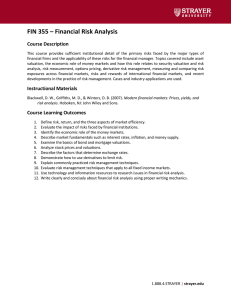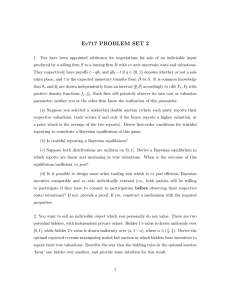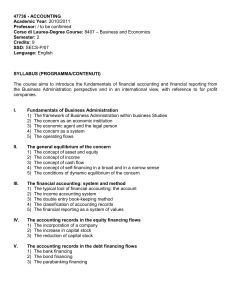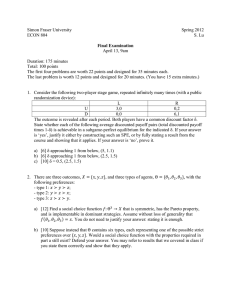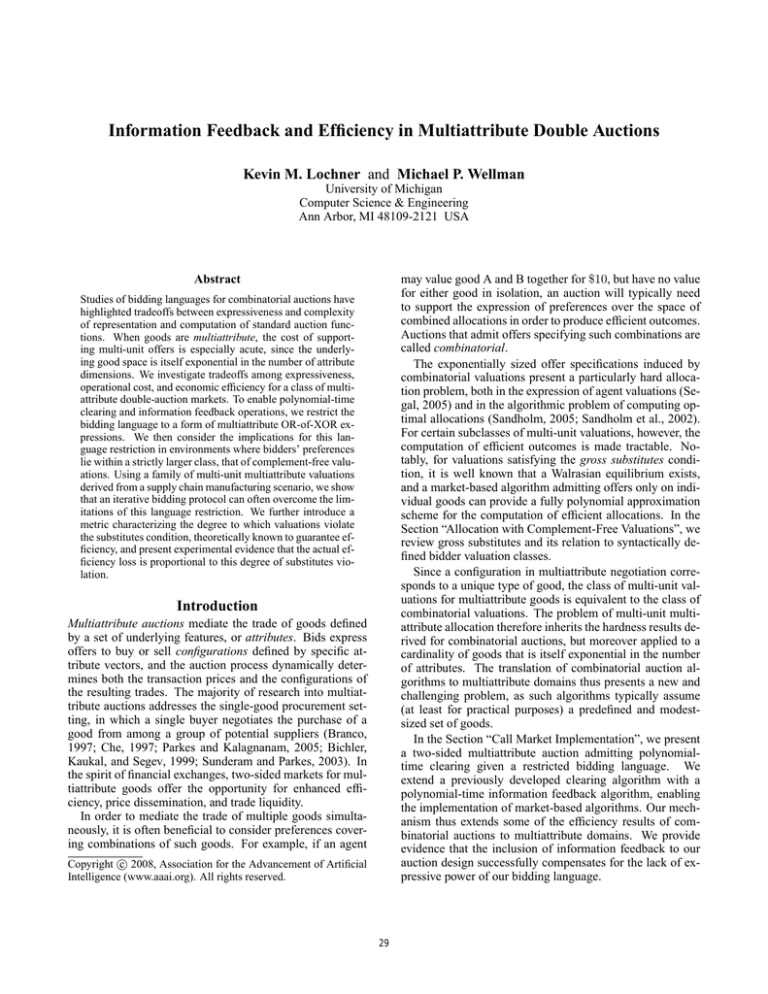
Information Feedback and Efficiency in Multiattribute Double Auctions
Kevin M. Lochner and Michael P. Wellman
University of Michigan
Computer Science & Engineering
Ann Arbor, MI 48109-2121 USA
may value good A and B together for $10, but have no value
for either good in isolation, an auction will typically need
to support the expression of preferences over the space of
combined allocations in order to produce efficient outcomes.
Auctions that admit offers specifying such combinations are
called combinatorial.
The exponentially sized offer specifications induced by
combinatorial valuations present a particularly hard allocation problem, both in the expression of agent valuations (Segal, 2005) and in the algorithmic problem of computing optimal allocations (Sandholm, 2005; Sandholm et al., 2002).
For certain subclasses of multi-unit valuations, however, the
computation of efficient outcomes is made tractable. Notably, for valuations satisfying the gross substitutes condition, it is well known that a Walrasian equilibrium exists,
and a market-based algorithm admitting offers only on individual goods can provide a fully polynomial approximation
scheme for the computation of efficient allocations. In the
Section “Allocation with Complement-Free Valuations”, we
review gross substitutes and its relation to syntactically defined bidder valuation classes.
Since a configuration in multiattribute negotiation corresponds to a unique type of good, the class of multi-unit valuations for multiattribute goods is equivalent to the class of
combinatorial valuations. The problem of multi-unit multiattribute allocation therefore inherits the hardness results derived for combinatorial auctions, but moreover applied to a
cardinality of goods that is itself exponential in the number
of attributes. The translation of combinatorial auction algorithms to multiattribute domains thus presents a new and
challenging problem, as such algorithms typically assume
(at least for practical purposes) a predefined and modestsized set of goods.
In the Section “Call Market Implementation”, we present
a two-sided multiattribute auction admitting polynomialtime clearing given a restricted bidding language. We
extend a previously developed clearing algorithm with a
polynomial-time information feedback algorithm, enabling
the implementation of market-based algorithms. Our mechanism thus extends some of the efficiency results of combinatorial auctions to multiattribute domains. We provide
evidence that the inclusion of information feedback to our
auction design successfully compensates for the lack of expressive power of our bidding language.
Abstract
Studies of bidding languages for combinatorial auctions have
highlighted tradeoffs between expressiveness and complexity
of representation and computation of standard auction functions. When goods are multiattribute, the cost of supporting multi-unit offers is especially acute, since the underlying good space is itself exponential in the number of attribute
dimensions. We investigate tradeoffs among expressiveness,
operational cost, and economic efficiency for a class of multiattribute double-auction markets. To enable polynomial-time
clearing and information feedback operations, we restrict the
bidding language to a form of multiattribute OR-of-XOR expressions. We then consider the implications for this language restriction in environments where bidders’ preferences
lie within a strictly larger class, that of complement-free valuations. Using a family of multi-unit multiattribute valuations
derived from a supply chain manufacturing scenario, we show
that an iterative bidding protocol can often overcome the limitations of this language restriction. We further introduce a
metric characterizing the degree to which valuations violate
the substitutes condition, theoretically known to guarantee efficiency, and present experimental evidence that the actual efficiency loss is proportional to this degree of substitutes violation.
Introduction
Multiattribute auctions mediate the trade of goods defined
by a set of underlying features, or attributes. Bids express
offers to buy or sell configurations defined by specific attribute vectors, and the auction process dynamically determines both the transaction prices and the configurations of
the resulting trades. The majority of research into multiattribute auctions addresses the single-good procurement setting, in which a single buyer negotiates the purchase of a
good from among a group of potential suppliers (Branco,
1997; Che, 1997; Parkes and Kalagnanam, 2005; Bichler,
Kaukal, and Segev, 1999; Sunderam and Parkes, 2003). In
the spirit of financial exchanges, two-sided markets for multiattribute goods offer the opportunity for enhanced efficiency, price dissemination, and trade liquidity.
In order to mediate the trade of multiple goods simultaneously, it is often beneficial to consider preferences covering combinations of such goods. For example, if an agent
c 2008, Association for the Advancement of Artificial
Copyright Intelligence (www.aaai.org). All rights reserved.
29
added to the order book, Ω, of the auction, comprising the
collection of all active buy and sell bids:
Theoretical work is largely silent on the efficiency of
market-based algorithms given valuations violating gross
substitutes. In the Section “Multiattribute Valuations”, we
present natural ways in which complement-free valuations
may violate the gross substitutes condition, invalidating the
efficiency guarantee of market-based approaches. In an
effort to quantify the expected performance limits of our
mechanism against a larger class of valuations, we introduce a new metric on bidder valuations, based on the severity by which valuations violate gross substitutes. We apply
this metric to a family of valuations, derived from a supply chain manufacturing scenario, and present simulation
results demonstrating a correlation between our metric and
expected market efficiency.
Ω = {Ωb , Ωs } = {{b1 , b2 , . . . , bc }, {bc+1 , . . . , bc+s }}.
When an auction determines the allocations and payments
of participants, the process is referred to as clearing. In a
clear operation, the auction computes a global allocation
{Θb , Θs } comprising an assignment of individual allocations and associated payments:
s
s
{{θ1b , θ2b , . . . , θcb }, {θc+1
, . . . , θc+s
}},
where θib = (gi , pi ) defines an allocation gi supplied to
buyer i in exchange for payment pi , and θjs = (gj , pj ) defines an allocation of gj supplied by seller j, who receives
payment pj .
A global allocation is feasible if the set of goods allocated
to buyers is contained in the set of goods supplied by sellers,
and the net payments are non-negative.
Auction Preliminaries
Auctions mediate the trade of goods among a set of selfinterested participants, or agents, as a function of agent messages, or bids. In a multiattribute auction, goods are defined
by vectors of attributes, a = (a1 , . . . , am ), aj ∈ Aj . A configuration, x ∈ X, is a particular attribute vector, where each
configuration can be thought of as a unique type of good.
An allocation, g ∈ G, is a multiset of such goods, that
is, a set possibly containing more than one of each type. A
multiset of goods can be formally defined as a pairing of an
underlying set of goods, and a function mapping that set to
the positive integers:
feasible(Θb , Θs ) ⇐⇒
(
P
P
∀x ∈ X,
Qgi (x) ≤ j∈S Qgj (x)
i∈C
P
P
(gi ,pi )∈Θb pi −
(gj ,pj )∈Θs pj ≥ 0
A global allocation is acceptable if individual payments
meet the reserve price constraints expressed in the bids of
buyers and sellers.
acceptable(Θb , Θs |Ω) ⇐⇒
∀(gi , pi ) ∈ Θb , r(gi , bi ) ≥ pi
∀(gj , pj ) ∈ Θs , r(gj , bj ) ≤ pj
g = (N, m)|N ⊆ X ∧ Q : N 7→ ZZ + ,
where for any x, Q(x) defines the quantity of x. We use
Qg (x) to denote the quantity of good x for allocation g.
Bids define one or more offers to buy or sell goods. An
offer pairs an allocation and a reserve price, (g, p), where
g ∈ G and p ∈ <+ . For a buy offer, the reserve price indicates the maximum payment a buyer is willing to make in
exchange for the set of goods comprising allocation g. Similarly, the reserve price of a sell offer defines the minimum
payment a seller is willing to receive to provide allocation g.
A bid, b ∈ B, defines a set of offers (often implicitly)
which collectively define an agent’s reserve price over the
space of allocations. We use the term valuation to designate
any mapping from the space of allocations to the positive
real numbers: v : G 7→ <+ , hence a bid defines a valuation.
For ease of explication, we use the function r : G×B 7→ <+
to indicate the reserve price of a bid for a given allocation.
The bidding language of an auction defines the syntax of
allowable bids, thereby defining the space B of expressible
bids.
We divide agents into buyers C = {1, . . . , i, . . . , c} and
sellers S = {c + 1, . . . , j, . . . , c + s}.1 Each bidder has a
single bid, bi for buyer i and bj for seller j. Upon receiving
a new or revised bid, the auction determines whether the bid
is admissible given its current state. If admissible, the bid is
We can now formalize the clear operation as computing
a feasible and acceptable global allocation based on the order book. There typically will be multiple global allocations
which are both feasible and acceptable. The auction selects
one such allocation based on its clearing policy, which defines the timing and implementation of the clear operation
as a function of the auction state.
We assume agents have preferences over alternative allocation and payment outcomes which can be represented
with quasilinear utility functions, meaning that utility is linear in payments. Buyer i then has quasilinear utility function ui (g, p) = vi (g) + p, where valuation vi defines the
net change in buyer utility when supplied with a given allocation, and p defines the net payments made to the buyer.
Similarly, seller j has utility function uj (g, p) = −vj (g)+p,
where valuation vj is interpreted as a cost function for supplying allocations.
The bidder allocations and payments determine the realized utilities of all agents. If a clear operation maximizes the
sum of all realized agent utilities, that is, the global surplus,
we call the auction efficient. An obstacle in determining an
efficient global allocation is that the auction must compute
agent allocations without direct observation of the agent valuations. An intermediate goal of the auction process is therefore to elicit agent preference information. This elicitation
happens by way of the agent bids. In signifying willing
deals, bids place bounds on the agent valuations.
1
This assumption precludes settings in which agents wish to
simultaneously buy and sell goods. We could accommodate such
agents to some extent by allowing them to bid under separate buyer
and seller identities.
30
Syntactic Valuation Classes
In a direct revelation mechanism, each agent submits at
most a single bid, in the form of a valuation, without receiving any information about the bids of other agents. To
the extent that bids accurately reflect valuations, a directrevelation auction can use bids as proxies for underlying
valuations, and maximize the objective function for the valuations expressed through bids. The extent to which bids
do not accurately reflect agent valuations may induce suboptimal global allocations, as the optimization procedure is
performed over an inaccurate objective function. A bidding language which is syntactically unable to fully convey
agent valuations may therefore induce natural efficiency limitations in a direct-revelation mechanism. Importantly, the
computational complexity of identifying an efficient global
allocation increases with the expressiveness of the bidding
language. This creates a natural tension between computational complexity and auction efficiency in many settings.
In iterative auctions, agents revise their bids over time
based on summary information provided by the auction
about the current auction state. Summary information is typically derived from the clearing algorithm given the current
auction state, informing agents of their current hypothetical allocations as well as price quotes indicating the minimum or maximum prices to buy or sell allocations (Wurman,
Wellman, and Walsh, 2001). Iterative mechanisms support
the implementation of market-based algorithms, which can
augment the range of bidder valuations admitting efficiency
for a given bidding language.
Syntactic valuations are built from atomic valuations and
operators on those valuations.
Definition 2 The atomic valuation (x, p) gives the value p
to any allocation containing a unit of configuration x, and
value zero to all other allocations.
Next, define the operators OR and XOR over valuations as
follows:
Definition 3 Let v1 and v2 be two valuations defined on the
space G of allocations. The valuations v1 + v2 (OR) and
v1 ⊕ v2 (XOR) are defined by:
(v1 + v2 )(g) = max(v1 (x) + v2 (g \ x)),
x⊆g
(v1 ⊕ v2 )(g) = max(v1 (g), v2 (g)).
Informally, the valuation (v1 + v2 )(g) divides up allocation g among valuations v1 and v2 such that the sum
of the resulting valuations is maximized. The valuation
(v1 ⊕v2 )(g) gives the entire allocation to v1 or v2 , depending
on which values g higher.
Subclasses of complement-free valuations are derived by
placing restrictions on how the OR and XOR operators may
be combined. Class OS valuations are created using only
the OR operator over atomic valuations, and allow for the
expression of additive valuations. Class XS valuations are
created by applying the XOR operator over atomic valuations, and allow for the expression of substitute valuations.
Any valuation composed of OR and XOR (applied in an arbitrary order) falls into class XOS, and is expressible by applying the XOR operator over OS valuations. The best approximation factor that can be guaranteed for XOS valuations in polynomial time is known to be bounded above by
2, and bounded below by 34 (Dobzinski, Nisan, and Schapira,
2005).
Allocation with
Complement-Free Valuations
Before devoting attention to multi-unit multiattribute allocation, it is instructive to revisit complexity results for the
more simple setting of combinatorial allocation. We restrict attention to complement-free bidder valuations. Noncomplementarity assumptions are common in Economics,
including diminishing marginal utilities for consumers and
decreasing returns to scale for producers (Mas-Colell, Whinston, and Green, 1995).
The class of complement-free buyer valuations contains
all valuations which are not superadditive over configurations.
OXS Valuations
Applying the OR operator over XS valuations yields valuations of class OXS.
Definition 4 A valuation is OXS if expressible through the
application of OR operators over XS valuations.
For example, as a buy bid, the valuation
Definition 1 A buyer valuation is complement-free (CF) if
for any two allocations ga and gb ,
(x1 , p1 ) + ((x2 , p2 ) ⊕ (x3 , p3 ))
v(ga ) + v(gb ) ≥ v(ga ∪ gb ).
expresses the willingness to buy either x1 at a price of p1 ,
and independently expresses a willingness to buy either x2
at a price of p2 , or x3 at a price of p3 (but not both), giving
the following acceptable allocations:
A seller valuation (cost function) is complement-free it is
not subadditive over configurations, that is, the direction of
the above inequality is reversed for sellers.
It is known that no polynomial clearing algorithm can
guarantee better than a 2-approximation for the general class
CF (Dobzinski, Nisan, and Schapira, 2005). In the following
subsections, we present subclasses of CF of increasing complexity (Lehmann, Lehmann, and Nisan, 2006), providing
known efficiency bounds for polynomial-time allocation.2
{(x1 , p2 ), (x2 , p2 ), (x3 , p3 ), ({x1 , x3 }, p1 + p3 ),
({x1 , x2 }, p1 + p2 )}.
If all valuations are of class OXS, the clearing problem
can be formulated as a polynomial-time bipartite matching
problem given class OXS bids.
2
In the multiattribute setting, unique goods correspond to the
configurations. We borrow both notation and analytical complexity
results from Lehmann et al. in this section, with notation amended
slightly for multiattribute domains.
31
Gross Substitutes
Definition 7 (Multiattribute Point) A multiattribute point
of the form (x, p, q) indicates a willingness to buy up to total
quantity q of configuration x at a unit price no greater than
p (for q > 0). Conversely, negative quantity (q < 0) would
indicate a willingness to sell up to q units at a price no less
than p.
Participants in multiattribute auctions often wish to buy
or sell one of several alternative configurations. This would
happen, for example, if a buyer wishes to procure computers, and is willing to accept multiple alternatives with respect to attributes such as processor type/speed, memory
type/size/speed, etc., but has a configuration-dependent reserve price.
Definition 8 (Multiattribute XR Unit) A multiattribute XR
unit is a triple (configs, prices, quantity) of the form
((x1 , x2 , . . . , xN ), (p1 , p2 , . . . , pN ), q), indicating a willingness to trade any combination of configurations
(x1 , x2 , . . . , xN ) at unit prices (p1 , p2 , . . . , pN ) up to total
quantity |q|, where q > 0 indicates a buy offer, q < 0 indicates a sell offer.
An XR unit with positive (negative) quantity expresses a
willingness to accept (provide) any allocation of total quantity not greater than |q|, given that the total payment is not
greater (less) than the sum of the unit prices expressed. For
example, given XR unit ((x1 , x2 , x3 ), (p1 , p2 , p3 ), 4), the allocation {x1 , x1 , x2 } would be acceptable at total payment
not greater than p1 + p1 + p2 .
In a slight abuse of notation, we define the r operator over
an XR unit and a configuration to denote the reserve price for
the given configuration in the XR unit, that is, r(XR, x) = p
selects the unit reserve price for configuration x in the XR
unit. Note that a Multiattribute Point is equivalent to an XR
unit with 1-tuple configurations and prices. To simplify the
syntax of our examples, we use the Multiattribute Point notation when an XR unit defines a reserve price for only a
single configuration.
We use a slightly more expressive bidding language in
the multiattribute call markets implemented here, which is
an OR extension of the XR unit.
Definition 9 (Multiattribute OXR Bid) A multiattribute
OXR bid is a set of multiattribute XR units,
{XR1 , XR2 , . . . , XRM }, indicating a willingness to trade
any combination of configurations such that the aggregate
allocation and payments to the bidder can be divided among
the XR units such that each (g, p) pair is consistent with its
respective XR unit.
The bidding language constructs presented here can be
classified within the syntactic framework presented above.
The multiattribute point (x, p, q) expresses the valuation
equivalent to an OR expression over |q| atomic (x, p) valuations:
To define valuations exhibiting gross substitutability, we first
define an agent demand correspondence with respect to valuations and prices. The following definitions are with respect
to buyers.
Definition 5 Given valuation v and vector of configuration
prices p~ = (px1 , px2 , . . . , pxn ), the demand correspondence
d(v|~
p) maps to the set of allocations which maximize v(g) −
P
x∈g px .
Definition 6 A valuation v is of class GS if for any price
vectors p~ and ~q with pi ≤ qi ∀i and g1 ∈ d(v|~
p), there exists
g2 ∈ d(v|~q) such that {x ∈ g1 |px = qx } ⊂ g2 .
Informally, the gross substitutes condition for buyers
states that the demand for a given configuration is nondecreasing in the price of any other configuration. For sellers,
the condition changes so that the supply of a given configuration is nonincreasing in the price of other configurations.
Valuations satisfying the gross substitutes condition admit
efficiency through market-based algorithms. Market-based
algorithms derive from the ideas of general equilibrium theory (Arrow, Block, and Hurwicz, 1959), under which markets simultaneously maximize efficiency and achieve a perfect balance of supply and demand, given profit-maximizing
behavior of market participants. The condition of gross substitutes has been identified in a number of settings as sufficient to guarantee existence of a Walrasian equilibrium (Arrow, Block, and Hurwicz, 1959; Kelso and Crawford, 1982;
Gul and Stacchetti, 1999; Milgrom and Strulovici, 2006).
Market-based algorithms operate by iteratively providing
agents with price quotes, requiring that agents express demand sets reflecting their optimal consumption or production choices at the given prices. Demand sets are expressible
in any bidding language of complexity equal to or greater
than class OS. Prices are adjusted at each iteration based on
the relative supply and demand of each type of good, until
the market reaches equilibrium. Computationally, marketbased algorithms provide a fully polynomial approximation
scheme, with complexity that is polynomial in the number of
bidders, goods, and the inverse of the approximation factor
(Lehmann, Lehmann, and Nisan, 2006).
Call Market Implementation
In this section, we present the bidding language and algorithms supporting our multiattribute call market implementation, and present complexity results for this mechanism more precisely. Although we present only the discrete
configuration-based bidding language employed in our simulations, both the clearing and information feedback algorithms presented here admit the more general bid forms described by Engel, Wellman, and Lochner (2006).
Bidding Language
(x, p) + (x, p) + · · · .
|
{z
}
As discussed, goods are assumed to be defined by a set of attributes, where a given instantiation of attributes designates
a configuration. The most simple multiattribute bidding unit
expresses a maximum/minimum price at which to trade a
given quantity of a single configuration.
total of |q| elements
The additional quantity designation in a multiattribute
point provides compactness over the equivalent OR expression when valuations are linear in quantity.
32
The multiattribute XR unit with quantity q defines the valuation equivalent to the following expression over atomic
valuations:
and link surplus (equivalently, negative link costs) equal to
the values of MMPs on BX × SX.
The optimal solution flow along a given link designates a
quantity traded between the traders whose bids contain the
respective XR units, and the configuration to be traded is the
solution to MMPx between the XR units.
((x1 , p1 ) ⊕ · · · ⊕ (xN , pN ))+
((x1 , p1 ) ⊕ · · · ⊕ (xN , pN )) + · · ·
|
{z
}
total of |q| elements
Information Feedback
The multiattribute XR unit is less expressive than the general class OXS because it defines an OR over a set of identical
XOR expressions, thus imposing a constraint that valuations
be linear in quantity, and configuration parity, that is, the
quantity offered by a bid is configuration-independent (Engel, Wellman, and Lochner, 2006). The multiattribute OXR
bid provides full expressiveness with respect to class OXS.
In addition to reducing the complexity of clearing, the decomposition of GMAP into MMP and subsequent network
optimization reduces the complexity of computing quote information. The single-unit quote defines a limit on the offer
price to trade a single unit of a configuration. The MMP
process translates this price into a bilateral surplus for each
offer in the order book, and the network flow optimization
determines whether the offer will transact based on these bilateral surpluses. A quote for a given configuration can be
found by first finding the required surplus (i.e., solution to
MMPs ) for a new bilateral trade to be included in the efficient set, and then determining the price level for any given
configuration as a function of that surplus. The computed
price will be the quote for a (configuration, trader ) pair;
taking the min/max over all sellers/buyers yields the ask/bid
quote for a configuration.
As an example, consider calculating the bid quote for x
given a set of XR units comprised of buys BX and sells SX.
Each XR unit is a node in the network flow graph, with link
surplus defined as above. We first add a dummy node (XRD )
to the graph and connect that node to one of the nodes of
BX (XRi ). We must now calculate the link surplus which
increases the value of the optimal network flow. The computed link quote, LQi , is the trade surplus (i.e., solution to
MMPs (XRi , XRD )) which is required for a new bid to trade
with node XRi . The link quote for each buy node must be
calculated, producing a link quote for each XRi ∈ BX. The
bid quote for a given configuration x is then:
Clearing
Previous work (Engel, Wellman, and Lochner, 2006) explored the connection between bidding languages and clearing algorithms for this domain. Here we provide the main
results but present them for only the OXR bidding language
presented above. The result holds for more general conditions on the bidding language as described in the earlier paper.
Clearing the market requires finding the global allocation
that maximizes the total trade surplus, which is the Global
Multiattribute Allocation Problem (GMAP). For a certain
class of bids, which includes OXR bids, GMAP can be divided into two discrete steps: identifying optimal bilateral
trades (the Multiattribute Matching Problem, MMP), then
maximizing total surplus as a function of those trades.
In the case of OXR bids, the multiattribute matching problem determines the optimal configuration x to trade between each pair of buy and sell XR units. For buy XR
unit XRb = (configs b , prices b , q b ) and sell XR unit XRs =
(configs s , prices s , q s ),
MMPx (XRb , XRs ) = argmax[r(XRb , x) − r(XRs , x)].
max (r(XRi , x) − LQi ).
XRi ∈BX
x∈X
The MMP surplus is also necessary to compute a solution
to GMAP:
It should be apparent from the max operation that once all
link quotes have been determined, configuration quotes can
be computed with complexity on the order of the number
of XR units. This implies that the complexity of computing a single configuration quote is invariant to the size of
attribute space when the GMAP-MMP decomposition is applicable. Although computing quotes for all configurations
entails complexity that is linear in the number of configurations, a bidder-driven query process for configuration quotes
may still support market-based algorithm efficiency in large
or continuous attribute domains.
The computation of link quotes on the network flow graph
is also achievable in polynomial time, using a specialization
of the cycle-canceling algorithm (Ahuja, Magnanti, and Orlin, 1993). Given that computation of a link quote requires
perturbing the optimal network flow by quantity of only a
single unit, the cycle-canceling algorithm can be adapted to
a shortest-path algorithm, where an all-pairs shortest-path
algorithm computes all required link quotes with complexity that is polynomial in the number of XR units. In practice,
MMPs (XRb , XRs ) = max[r(XRb , x) − r(XRs , x)].
x∈X
Define the set BX as the set of all XR units contained in the
buyers’ OXR bids, and the set SX as the set of all XR units in
the sellers’ OXR bids. For bi = {XRi,1 , XRi,2 , . . . , XRi,M }
for buyer i ∈ C and bj = {XRj,1 , XRj,2 , . . . , XRj,M } for
seller j ∈ S,
[ [
BX =
XRi,k ,
i∈C XRi,k ∈bi
[ [
SX =
XRj,k .
j∈S XRj,k ∈bj
In this case, the multiattribute matching problem is performed between each pair in BX × SX. GMAP is then formulated as a network flow algorithm, specifically the transportation problem, with source nodes SX, sink nodes BX,
33
At these prices, the optimal production bundle is (x1 , x4 )
which yields a surplus of 4. If the price of x1 drops to zero,
the optimal production bundle becomes (x2 , x3 ), yielding a
surplus of 2. Hence, the supply of x4 decreases with a decrease in the price of x1 , which violates the gross substitutes
condition for sellers.
we require two iterations of the shortest-path algorithm, one
iteration each for bid quotes and ask quotes.
Multiattribute Valuations
The call market presented above supports the direct expression of OXS valuations, with information feedback supporting the implementation of market-based algorithms for efficiency under GS valuations. Unfortunately, many valuations
natural for multiattribute domains fall outside of class OXS.
For example, Bichler and Kalagnanam (2005) cite the common need to enforce homogeneity of allocations, meaning
that all configurations in an allocation must have identical
values for one or more attributes. Valuations which place
higher values on homogeneous allocations, or conversely,
heterogeneous allocations, are expressible with an XOS bidding language but not with a language of class OXS.
Our motivation in studying allocation with valuations of
increasing complexity arose when applying our mechanism
to a supply chain manufacturing scenario. In the Trading Agent Competition Supply Chain Management Game
(Arunachalam and Sadeh, 2005), manufacturers assemble
finished goods from a limited inventory of available components. As Example 1 makes clear, the induced seller valuations fall outside of class OXS, and may violate the gross
substitutes condition.
A New Valuation Metric
Given the ability to implement market-based algorithms, the
question remains as to the efficiency limitations of our market design when valuations are not contained in GS. To better characterize the settings for which market-based algorithms are appropriate, in this section we define a new metric that assesses the degree to which a valuation violates the
GS conditions.
Gross Substitutes Revisited
As defined above, the gross substitutes condition requires
that the demand for goods be nondecreasing in the prices of
other goods. The motivation behind this condition is that a
price adjustment process will ultimately reach equilibrium
if a price perturbation intended to reduce the demand of
over-demanded goods does not reduce the demand for other
under-demanded goods. Similarly, a price decrease intended
to increase demand for under-demanded goods should not
increase demand for over-demanded goods.
For valuation v satisfying the gross substitutes condition,
the demand correspondence condition holds for all price
vectors and perturbations. Formally, given demand correspondence d(v|~
p) as defined previously,
the set of allocaP
tions maximizing the sum v(g) − x∈g px , for all vectors
of configuration prices p~ = (px1 , px2 , . . . , pxn ) ∈ <n+ , and
−
→
p)
all single price perturbations dp ∈ <n+ , for any g1 ∈ d(v|~
there exists g2 ∈ d(v|~q) such that {x ∈ g1 |px = qx } ⊂ g2 ,
−
→
where ~q = p~ + dp.
Example 1 Consider the case of a PC built from two components: cpu and memory. Assume that a seller has one
unit of cpu = fast, one unit of cpu = slow , one unit each
for memory ∈ {large, medium, small }, and the configurations are assembled in the following manner:
1. configuration x1 : {fast, large}
2. configuration x2 : {fast, medium}
3. configuration x3 : {slow , small }
4. configuration x4 : {slow , medium}
The production possibilities are then:
Gross Substitutes Violations
{x1 , x4 }, {x1 , x3 }, {x2 , x3 }.
We hypothesize that the degree to which the gross substitutes condition is violated is a more accurate metric on valuations in assessing the likely existence of equilibrium and
the efficiency of market-based algorithms.
−
→
For non-negative vectors p~ and dp, again define ~q = p~ +
−
→
dp. For each gi ∈ d(v|~
p), we define the gross substitutes
violation as follows:
The induced seller valuation is not expressible using an OXS
language. The nearest OXR bid approximations require the
seller to either overstate (bid 1) or understate (bids 2 and 3)
his production capabilities:
(((x1 , x2 ), (p1 , p2 ), −1), ((x3 , x4 ), (p3 , p4 ), −1))
((x1 , p1 , −1), ((x3 , x4 ), (p3 , p4 ), −1))
(((x1 , x2 ), (p1 , p2 ), −1), (x3 , p3 , −1))
(1)
(2)
(3)
GSV(v, p~, ~q, gi ) =
min | {x ∈ gi |px = qx } \ {x ∈ g|px = qx } | .
The valuations from Example 1 are also not in class GS.
Assume that within the above production possibilities, the
seller has a unit cost of 3 for all configurations, with total cost additive in unit cost. The equivalent XOS valuation
would be:
g∈d(v|~
q)
Intuitively, this measure counts the number of violations
of the gross substitutes condition for a specific initial price
vector and price change. Valuations satisfying the gross substitutes condition will have a violation count of zero for all
initial prices, demand sets, and perturbations. Valuations
which do not satisfy the gross substitutes condition will have
positive values of GSV for one or more combinations of
−
→
(~
p, dp, g).
((x1 , 3)+(x4 , 3))⊕((x1 , 3)+(x3 , 3))⊕((x2 , 3)+(x3 , 3)).
Prices for configurations are also necessary to evaluate the
gross substitutes condition. Assume the following configuration prices:
p(x1 ) = 5; p(x2 ) = 4; p(x3 ) = 4; p(x4 ) = 5.
34
Valuation Generation
To simplify the exposition, we assume d(v|~
p) maps to a
single g for any p~, and use x ∈ d(v|~
p) to indicate a good
from that demand set.
From any single price vector p~, define the gross substitutes violation of a valuation for that price vector as the average GSV over all minimal single-price perturbations which
ensure a new demand set:
Our experimental approach to generating a configuration
structure is to generate random configurations until a total
of 20 unique configurations is produced. For each configuration, we probabilistically include any one of eight unique
components in the configuration (i.e., configurations may
have variable numbers of components), while additionally
requiring that any single configuration have at least three
components.
Once we have generated a set of 20 configurations, we
randomly sample costs and inventory to generate a seller valuation. Sellers have both component inventories and costs
drawn i.i.d. Seller inventory for each component is drawn
from the discrete uniform distribution [0, 3], while seller
costs per component are drawn from the discrete uniform
distribution [30, 80].
We then test the induced valuation with respect to the
same price distribution from which agent valuations are
drawn. We sample prices, and for each price sample p~, we
compute GSV(v, p~). To compute GSV(v, p~), we first compute the optimal production set g ∗ = d(v|~
p), and sum the
gross substitutes violations over all minimal single prices
changes which ensure a new optimal production set.
We iterate the above process with random price samples
until the standard error of the expected gross substitutes violation is below .05, producing a single valuation. We generated a set of 100 valuations for each configuration structure, recording the costs and inventory, along with the EGSV
value for each such valuation. We generated and tested seller
valuations for 277 configuration structures, yielding a total
of 27700 seller valuations.
GSV(v, p~) =
n
1X
| {xj ∈ d(v|~
p)|px = qx } \ {x ∈ d(v|~q)|px = qx } | .
n i=1
where:
~q = (p1 , . . . , pi + dp i , . . . , pn )
and
dp i = min s.t. d(v|~
p) 6= d(v|(p1 , . . . , pi + dp, . . . , pn )).
dp
Next, define the expected gross substitutes violation for a
valuation as the expected value of GSV for random p~:
EGSV(v) = E[GSV(v, p~)],
where
∀i pi ∼ U [0, p̄].
Our hypothesis is that for a set of bidders with valuations
drawn from a small range of EGSV values, market-based algorithms will reach a similar degree of efficiency, where the
realized efficiency is decreasing in the average EGSV value.
This result would extend naturally to the case of gross substitutes (equivalently, an EGSV value of zero), where marketbased algorithms achieve full efficiency. The intuition behind the EGSV metric, specifically for using the expected
GSV of a valuation (the average, rather than the maximum
or minimum) is that since the price trajectory of a marketbased algorithm covers only a subset of the full price space,
the average violation factors in the probability of seeing any
specific violation.
Market Simulation
Each problem instance comprises a set of 10 buyers and 10
sellers. For each configuration structure, we first sort the set
of 100 generated seller valuations by EGSV values. We define a unique problem instance for each contiguous set of 10
seller valuations, using the previously generated inventories
and costs for each valuation, and taking the average EGSV
value of the 10 sellers to classify the problem instance (we
denote this average EGSV by aGSV). We thus generate 90
problem instances for each configuration structure.
We randomly generate buyer valuations for each problem
instance. Each buyer has demand for two units, with full
substitutability among the goods (i.e., each will accept any
combination of two goods at probabilistically generated configuration reserve prices). Buyer reserve prices are drawn
from the discrete uniform distribution [400, 500] for each
configuration.
For each problem instance, we first formulate the allocation problem as a linear program to determine the maximum
achievable efficiency. We then simulate bidding until quiescence, computing the fraction of maximal efficiency at quiescence. To quantify the benefit of information feedback,
we took the first iteration of bidding as the direct-revelation
outcome.
Although we believe that the direct expression of
substitutes—as in the OXR bidding language—is indispensable for large or continuous attribute domains, we conducted
Testing the EGSV -Efficiency
Relationship
To evaluate the relationship between EGSV values and market efficiency, we employed a component-based model of
configurations like that presented in Example 1, where valuation complexity is determined by the constitution of the
configurations, that is, the configuration structure, as well
as by the respective inventory levels and component costs of
sellers.
For example, a valuation defined on a configuration structure with three alternate configurations will violate GS to
the extent that swapping production from one configuration to another requires additional components that are allocated to the third configuration. Treating configurations
{x1 , x2 , x3 } as sets of components, assume that switching
production from x1 to x2 requires additional components
x2 \ x1 . If an agent has no additional inventory of the components (x2 \ x1 ) ∩ x3 then the induced valuation will have
a GSV of 1 for some price levels. In this way, variation both
in the composition of configurations and the inventory levels
of agents induces different levels of substitutability in agent
valuations.
35
ciency for low aGSV values (∼ 97%). We conjecture that
the majority of low EGSV valuations were also in class OXS,
and that given OXS valuations, the ability to express substitutability through bids provides a significant efficiency advantage in direct-revelation mechanisms.
Notable in Figure 1 is that the iterative mechanisms relatively outperform the direct OXR mechanism, by a margin
that is increasing in aGSV value. We suspect this reflects
bidder valuations which increasingly deviate from class OXS
with higher EGSV values. Despite this increasing valuation
complexity, the iterative mechanisms hold to a high level of
efficiency, falling only to approximately 95% as aGSV values reach 1. From this we conclude that information feedback is able to compensate for the lack of expressive power
of a class OXS bidding language.
We observe that the iterative OXR mechanism outperforms the OS mechanism over all aGSV values. We hypothesize that the direct expression of substitutes allows
the market-based algorithm to escape local maxima, as
our mechanism does not implement a provably convergent
market-based algorithm for OS bids.
the same bidding simulation with a class OS bidding language to determine whether the expression of substitutes
provides efficiency advantages in domains with small numbers of configurations. Each problem instance thus produces
4 data points (1 for each of (direct, iterative)×(OS, OXR)).
We simulated myopic best response bidding for buyers
and sellers, having buyers and sellers bid their true values
at each iteration on a profit-maximizing set of goods. Given
that the bidding language is not sufficiently expressive to directly reveal seller valuations, sellers are forced to approximate their valuations with bids. To generate an OS bid,
sellers find the feasible production bundle that maximizes
surplus at current prices (assuming a uniform price for all
configurations when quotes are not available). To generate
an optimal OXR bid, sellers start with the optimal OS bid,
subsequently expanding the bid to a feasible OXR bid.
Simulation Results
We aggregated the simulation results over all configuration
structures and sorted the data by aGSV value into 10 bins,
computing the sample mean of the achieved fraction of total
efficiency. Figure 1 plots the achieved fraction of maximal
efficiency as a function of aGSV value (with aGSV value
averaged over all samples within a bin), for both directrevelation and iterative mechanisms, for both the OS and
OXR bidding languages.
Conclusions
We investigated the problem of multi-unit multiattribute allocation through call-market auctions. We presented an implemented multiattribute call market supporting polynomialtime clearing and information feedback operations for a restricted class of bidding language. To our knowledge, this is
the first call market of its kind presented in literature.
We discussed the expected efficiency of our mechanism
from the perspective of known hardness results derived for
combinatorial auction settings, given complement-free bidder valuations. We discussed the efficiency of market-based
algorithms, and demonstrated that the information-feedback
functionality of our market design supports efficient allocations given valuations satisfying the gross substitutes condition.
Importantly, we demonstrated that the addition of information feedback functionality to our call market design successfully compensates for the expressive deficiencies imposed by a restricted bidding language. The addition of
information feedback support to our previously developed
clearing algorithm thus extends the range of bidder valuations for which our market design is able to support efficiency.
Inspired by a multiattribute supply chain setting, we presented natural ways in which multiattribute valuations may
violate the gross substitutes condition. Lacking theoretical
results as to the expected efficiency of our market design
for valuations likely to be encountered in practice, we presented a new metric on bidder valuations, derived from the
ways in which valuations violate the substitutes condition.
We then presented evidence that this metric correlates with
the expected efficiency of market-based algorithms. Also to
our knowledge, this is the first such experiment presenting
evidence of a correlation between the efficiency of marketbased algorithms and the measured gross substitutes violation of bidder valuations.
Figure 1: Mean efficiency for average realized EGSV.
For aGSV values close to zero, the substitutes condition
is nearly satisfied for all valuations, indicating that prices
inducing violations of the substitutes condition occur infrequently. For such problem instances, we would expect iterative mechanisms to reach nearly maximal efficiency. Figure 1 confirms this hypothesis, as both iterative mechanisms
average more than 97% efficiency for low aGSV values.
We note that while the direct OS mechanism suffers from
relatively lower efficiency across all aGSV values (∼ 90%),
the direct OXR mechanism achieves a high fraction of effi-
36
References
Sandholm, T. 2005. The winner determination problem. In
Cramton et al. Cramton, Shoham, and Steinberg (2005).
Segal, I. 2005. The communication requirements of combinatorial allocation problems. In Cramton et al. Cramton,
Shoham, and Steinberg (2005).
Sunderam, A. V., and Parkes, D. C. 2003. Preference elicitation in proxied multiattribute auctions. In Fourth ACM
Conference on Electronic Commerce, 214–215.
Wurman, P. R.; Wellman, M. P.; and Walsh, W. E. 2001. A
parametrization of the auction design space. Games and
Economic Behavior 35:304–338.
Ahuja, R. K.; Magnanti, T. L.; and Orlin, J. B. 1993.
Network Flows: Theory, Algorithms, and Applications.
Prentice-Hall, Inc.
Arrow, K. J.; Block, H. D.; and Hurwicz, L. 1959. On
the stability of competitive equilibrium, II. Econometrica
27:82–109.
Arunachalam, R., and Sadeh, N. M. 2005. The supply
chain trading agent competition. Electronic Commerce
Research and Applications 4:63–81.
Bichler, M., and Kalagnanam, J. 2005. Configurable offers and winner determination in multi-attribute auctions.
European Journal of Operational Research 160:380–394.
Bichler, M.; Kaukal, M.; and Segev, A. 1999. Multi-attribute
auctions for electronic procurement. In First IBM IAC
Workshop on Internet Based Negotiation Technologies.
Branco, F. 1997. The design of multidimensional auctions.
RAND Journal of Economics 28:63–81.
Che, Y.-K. 1997. Design competition through multidimensional auctions. RAND Journal of Economics 24:668–
680.
Cramton, P.; Shoham, Y.; and Steinberg, R., eds. 2005.
Combinatorial Auctions. MIT Press.
Dobzinski, S.; Nisan, N.; and Schapira, M. 2005. Approximation algorithms for combinatorial auctions with
complement-free bidders. In Thirty-Seventh Annual ACM
Symposium on Theory of Computing, 610–618.
Engel, Y.; Wellman, M. P.; and Lochner, K. M. 2006. Bid
expressiveness and clearing algorithms in multiattribute
double auctions. In Seventh ACM Conference on Electronic Commerce, 110–119.
Gul, F., and Stacchetti, E. 1999. Walrasian equilibrium with
gross substitutes. Journal of Economic Theory 87(1):95–
124.
Kelso, A. S., and Crawford, V. P. 1982. Job matching,
coalition formation, and gross substitutes. Econometrica
50:1483–1504.
Lehmann, B.; Lehmann, D.; and Nisan, N. 2006. Combinatorial auctions with decreasing marginal utilities. Games
and Economic Behavior 55(2):270–296.
Mas-Colell, A.; Whinston, M. D.; and Green, J. R. 1995.
Microeconomic Theory. New York: Oxford University
Press.
Milgrom, P., and Strulovici, B. 2006. Concepts and properties of substitute goods. Technical report, Economics
Group, Nuffield College, University of Oxford.
Parkes, D. C., and Kalagnanam, J. 2005. Models for iterative multiattribute Vickrey auctions. Management Science
51:435–451.
Sandholm, T.; Suri, S.; Gilpin, A.; and Levine, D. 2002.
Winner determination in combinatorial auction generalizations. In First International Joint Conference on Autonomous Agents and Multiagent Systems, 69–76.
37

